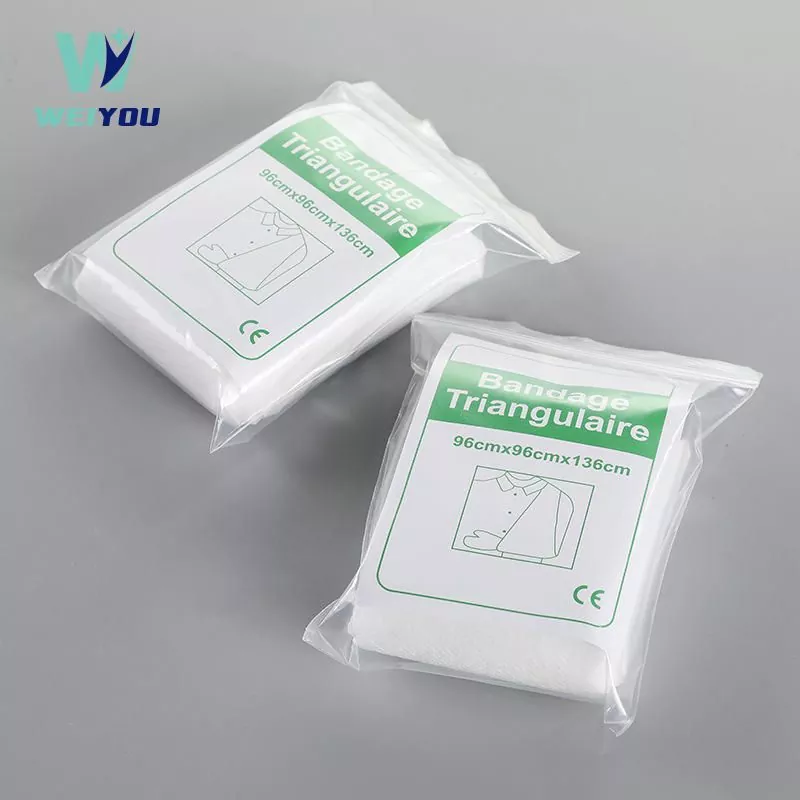- English
- Español
- Português
- русский
- Français
- 日本語
- Deutsch
- tiếng Việt
- Italiano
- Nederlands
- ภาษาไทย
- Polski
- 한국어
- Svenska
- magyar
- Malay
- বাংলা ভাষার
- Dansk
- Suomi
- हिन्दी
- Pilipino
- Türkçe
- Gaeilge
- العربية
- Indonesia
- Norsk
- تمل
- český
- ελληνικά
- український
- Javanese
- فارسی
- தமிழ்
- తెలుగు
- नेपाली
- Burmese
- български
- ລາວ
- Latine
- Қазақша
- Euskal
- Azərbaycan
- Slovenský jazyk
- Македонски
- Lietuvos
- Eesti Keel
- Română
- Slovenski
- मराठी
- Srpski језик
What is the difference between a compression bandage and a regular medical bandage?
2024-10-21

What is the difference between a compression bandage and a regular medical bandage?
Compression bandages and regular bandages serve different purposes. Compression bandages are meant to apply pressure to the injured area to reduce swelling and promote healing. They are commonly used in injuries such as ankle sprains, varicose veins, and deep vein thrombosis. On the other hand, regular medical bandages are designed to wrap around an injury to protect it from further harm or contamination. They are used in a variety of situations, from minor cuts and scrapes to surgical wound dressings.
What are the different types of medical bandages?
As mentioned earlier, medical bandages come in various types depending on the application. Aside from compression and regular medical bandages, other types include Triangular bandages, Elastic bandages, Tubular bandages, Cohesive bandages, and Adhesive bandages.
How do you properly apply a medical bandage?
To properly apply a medical bandage, you need to ensure that the injured area is clean and dry. You should also use the proper technique based on the type of bandage you are using. For example, when using a compression bandage, you need to start wrapping from the injured area moving upwards. When using a triangular bandage, you need to fold it properly and place it over the injury before tying it around the neck or head.
What are the materials used in medical bandages?
Medical bandages can be made of various materials such as gauze, cotton, polyester, and elastomers. Some bandages are also impregnated with substances such as silver, iodine, or collagen to aid in wound healing.
In conclusion, medical bandages play an important role in managing injuries and promoting healing. Whether you need to wrap a simple cut or apply a compression bandage to a sprain, knowing the type of bandage and how to apply it properly is crucial. Always consult with your healthcare provider before using any type of medical bandage.
Ningbo Weiyou Import & Export Co., Ltd. is a leading medical bandage manufacturer and exporter, providing high-quality medical bandages at competitive prices. Our products are made of high-quality materials and meet international standards. For inquiries and orders, please send an email to dario@nbweiyou.com.
10 Scientific Research Papers about Medical Bandages
1. Basmajian, J. V., & Slonecker, C. E. (1993). The management of medical support stockings by persons with chronic venous insufficiency. Journal of the American Podiatric Medical Association, 83(8), 431-437.
2. Bryskiewicz, A., Schreiter, S., Maxwell, J., & Garcia, M. (2013). Reducing readmissions and healthcare costs with venous leg ulcer care: a prospective cohort study. Journal of Wound Care, 22(12), 682-691.
3. DeLia D. (2011). Increasing the use of effective venous thromboembolism prophylaxis in hospitalized medical patients through electronic alerts. Archives of Internal Medicine, 171(17), 1620-1621.
4. Fong, K. D., & Chan, T. T. (2016). The use of compression hosiery in the prevention and management of lower limb lymphedema after cancer treatment. Clinics in Dermatology, 34(6), 690-694.
5. Healing Wounds Collaborative Group. (2018). Bilayer versus conventional dressing in treatment of diabetic foot ulcers: a randomized controlled trial. Lancet Diabetes & Endocrinology, 6(8), 647-655.
6. Kosiak, M., Wzorek, J., Tkacz, J., Dębski, R., & Dworak, J. (2013). The use of polyurethane foams in dressings and bandages. J Mater Sci: Mater in Medicine, 24(5), 1225-1232.
7. Lui, N. L., & Jaglal, S. B. (2012). Breast cancer-related lymphedema: a literature review for clinical practice. Journal of Medical Imaging and Radiation Sciences, 43(2), 97-107.
8. Semple, J. L., & Kirsner, R. S. (2013). Wound bed preparation and the role of enzymes: a case for multiple actions of therapeutic agents. Wounds: a compendium of clinical research and practice, 25(1), 19-26.
9. Stojkovic, D., Mitkovic, M., Brkic, T., & Milosevic, D. P. (2015). Use of foam dressings in the treatment of venous leg ulcers. Srpski arhiv za celokupno lekarstvo, 143(1-2), 10-16.
10. Yao, G., Zhang, L., & Chen, L. (2016). Compression Therapy Versus No Compression on Recurrent Ulceration Following Surgery for Varicose Veins: A Meta-analysis. Annals of vascular surgery, 30, 271-278.



